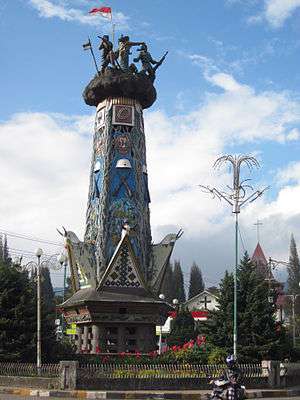Berastagi
| Berastagi | |
|---|---|
| district | |
|
Heroic Monument, Berastagi | |
| Country | Indonesia |
| Province | North Sumatera |
| Regency | Karo Regency |
| Elevation | 1,300 m (4,773 ft) |
| Population (2011 Census) | |
| • Total | 44,765 |
| Time zone | WIB (UTC+7) |
| Website | http://www.karokab.go.id/in/ |


Berastagi (Dutch: Brastagi), meaning "rice store", is a town and district of Karo Regency situated on crossroads on the main route linking the Karo highlands of Northern Sumatra to the coastal city of Medan. Berastagi town is 70 kilometers south of Medan and about 1,300 meters above sea level. The village rose to significance when Dutch settlers in Sumatra opened a boarding school there in the 1920s.
The main economic activities in Berastagi, centre on the colourful fruit and vegetable market and on tourism. Berastagi is famous for its passion fruit. The main attractions of the town are the two active volcanoes; Mount Sibayak, with its hot springs, and Mount Sinabung. Each mountain can be climbed in one day, but a guide is needed.[1]

The town is also a stop on the way to Lake Toba. The dominant ethnic and linguisitic group is Karo Batak.
Berastagi is 11 km from the capital Karo Regency government in Kabanjahe. Airport bus from Kabanjahe directly to the new Kuala Namu International Airport v.v. is available.
Berastagi district
The population of Berastagi district is 44,765, as of 2011. It is the second-most populous district in Karo Regency, after Kabanjahe.[2]
It borders Barusjahe and Tigapanah to the east, Simpang Empat, to the west, Deli Serdang Regency to the north and Kabanjahe to the south.
There are 9 administrative villages, called desa, in Berastagi district. It is the smallest (30.5 square kilometres), and most densely populated (1530 persons/square kilometre) district of Karo Regency.[3] Elevation is 1400 metres.
Desas with population (2007):[4]
- Gurusinga, 3,900
- Raya, 4,358
- Rumah Berastagi, 6,611
- Tambak Lau Mulgap I, 2,677
- Tambak Lau Mulgap II, 3,147
- Gundaling I, 8,388
- Gundaling II, 5130
- Sempajaya, 7,115
- Doulu, 2,011
Berastagi District has significantly more Islamic people than most parts of Karo Regency, with 17,801 Muslims, 5,042 Catholics, 19,195 Protestants, 1,245 Hindus or Buddhists, and 54 others. Sempajaya has the highest percentage of Muslims among the desas, being 67% Muslim. There are 11 mosques, 18 mushollas, 29 churches, and 2 viharas in the subdistrict.
97% of primary-age children are in school, but only 77% of high-school-age children. There are 26 junior schools, 8 middle schools, and 9 high schools within the district.
Agriculture is much less important in Berastagi (and Kabanjahe) than the rest of Karo Regency. Crops include scallions, common beans, peas, potatoes, cauliflower, cabbage, radish, chinese cabbage, tomatoes, carrots, and chayote. Rice is not a significant crop. Fruit grown include oranges, passionfruit, kaki and avocados. There is significantly more industry in Berastagi district than the rest of Karo Regency, aided by Berastagi's 100% paved roads.
References
- ↑ "Makanan Segar dan Pasar Ramai di Brastagi". Archived from the original on September 20, 2014. Retrieved June 2, 2014.
- ↑ "Archived copy". Archived from the original on 2011-03-04. Retrieved 2010-11-10.
- ↑ "Archived copy". Archived from the original on 2011-07-21. Retrieved 2010-11-10.
- ↑ http://bappeda.sumutprov.go.id/File_Upload/Data&Informasi/11_KCDA_KARO/BERASTAGI%20DALAM%20ANGKA%202008.pdf[]
External links
| Wikimedia Commons has media related to Brastagi. |
- Gov. Investment Agency - Tourism
-
 Berastagi travel guide from Wikivoyage
Berastagi travel guide from Wikivoyage
Coordinates: 3°11′N 98°31′E / 3.183°N 98.517°E
